Flood diehards: Riverside residents refusing to budge
- Published
Many of the victims of the Thames floods have been taken completely by surprise. But some of the stranded communities are riverbank dwellers who know this comes with the territory. On the Towpath in Shepperton, Surrey, BBC correspondent Sam Wilson found most residents cut off and flood-bound but fiercely determined to hold out.
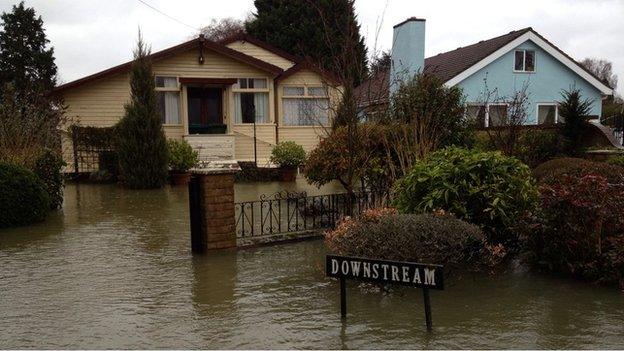
The Towpath runs along the riverbank for nearly a mile between Shepperton and Chertsey.
Some of the houses here are grand, but many are quite modest bungalows, which started out as wooden huts but have been rebuilt over the years, and in many cases raised on stilts to allow for flooding.
Most are therefore not wet inside. But this is the worst today's residents have seen - 5in (13cm) higher than the previous high-water mark in 2003, says one, Sally Pemberton.
Many are staying though some - especially those with young children - have moved out in the past few days.

Sally and Julian Pemberton, the Towpath
Sally Pemberton and her husband Julian say they will not leave their flooded home
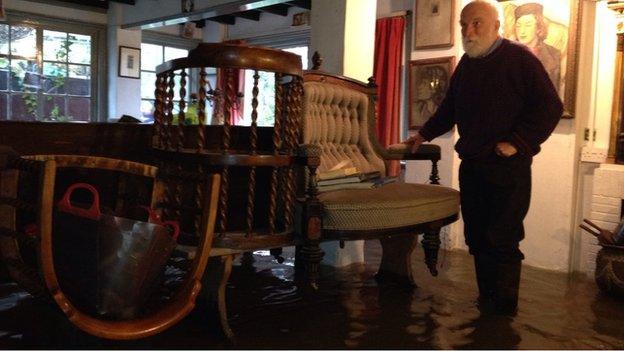
The Pembertons moved in 31 years ago.
They have been flooded downstairs so live mostly upstairs.
Her advice for living in a flooded house: "You have to be conscious of everything you do.
"Don't drop anything, and remember where you've moved things to.
"You must move very slowly - like T'ai Chi - so as not to make waves, as if they get in the fridge electrics you've had it."
She is 60, a beekeeper and former film-set artist.
Mr Pemberton is 81 and used to make props for films and TV.
Many of them adorn the garden, including a giant head of Napoleon, made for a dog-food advert.
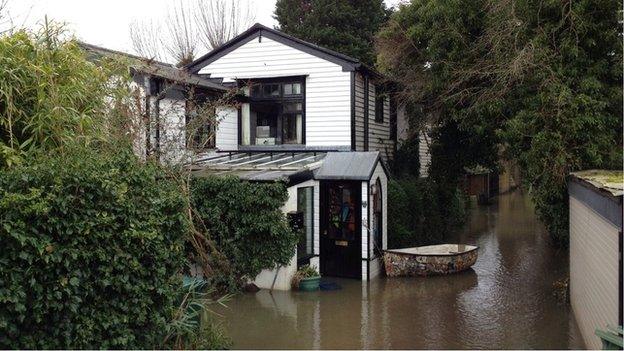
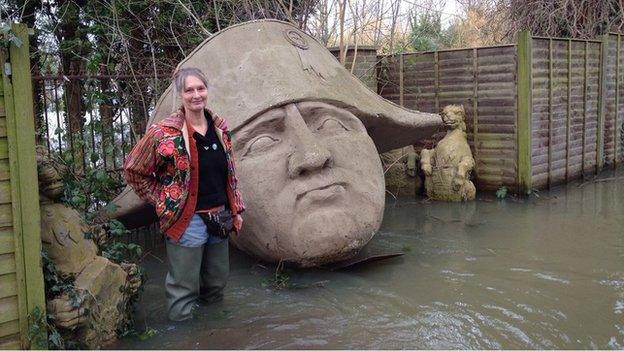
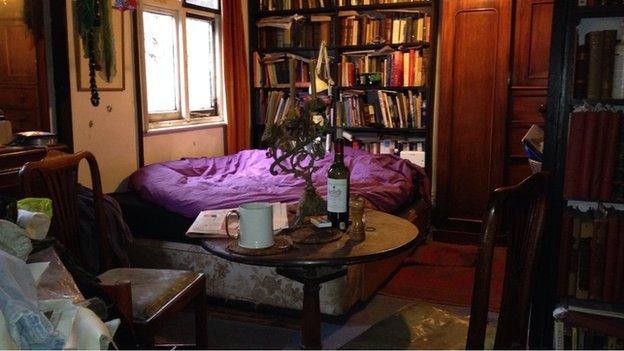
In their upstairs "bedsit" the Pembertons have still been able to enjoy candlelit dinners
The Pembertons moved to the river to be closer to nature. "I wanted to buy a boat," he says. "But we bought a house instead. But now it's much like living in a boat, anyway!"
She swims in the river every day of the year. But this week she has been able to swim in the back garden.
In their 31 years, they have been flooded four times - all in the past 13 years. The weather is changing, they say - but humans have exacerbated its effects.
"There's been building on the floodplain, of course.
"And at the back of our house there's 80 acres of what used to be flood meadow but had the gravel extracted, so where all that water would have gone is now a non-porous surface, which has been landfilled.
"So it's [largely down to] everybody making use of motorways, which we all do, and requiring gravel for concrete."

Alison Spooner, the Towpath

Thought to be the oldest resident along The Towpath at 96, Mrs Spooner may also be its most cheerful.
She is a widow but very self-reliant, doing her own cooking and many chores.
Alison Spooner: "It reminds me of the war years when we all mucked in together"
She has lifted some items of furniture but does not expect to be breached.
"I'm tough," she chuckles, in her lilac fleece. Is she staying put? "Oh yes!"
Her biggest issues are "keeping warm and keeping clean" as she does not want to run the bath.
"I've laid in plenty of medication for at least another month - I realised it wasn't going to be fun."
"There's tremendous local support. The local borough sent people round on Monday to ask if I needed anything. I said, 'I'm fine thanks very much.'
"I'm lacking the exercise in my poor old bones but other than that I'm content."
She moved in 36 years ago. "I like the water," she says. The holidays she takes - the most recent in September - are on narrowboat trips along Britain's canals.
Is the riverside a haven of middle-class wealth? "We bought in the 70s. We weren't rich then and I'm not rich now. Houses then were wooden, poor quality and cheap."
But she admits she has wealthy neighbours. "There's a bit of both."

The local community
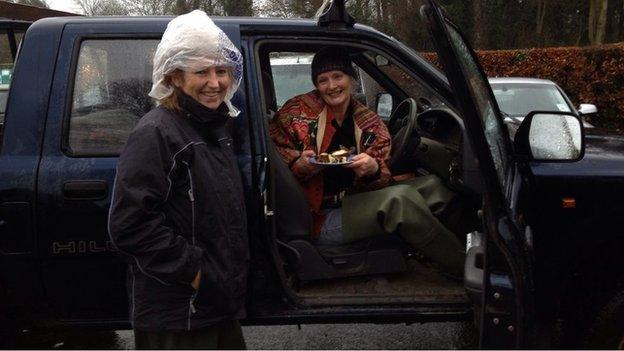
Councillor Vivienne Leighton (left) and Sally Pemberton check on their neighbours on the Towpath and may even offer some homemade sustenance
Some river dwellers like the peace and isolation it brings, but the flooding has brought people together more than usual.
"We're not in each other's pockets, but just cry for help and it comes from all quarters," Alison Spooner says.
Councillor Vivienne Leighton, who lives opposite the Towpath on Hamhaugh Island, has been invaluable in gathering and distributing information, and making sure vulnerable residents are looked after.
The Towpath is cut off from Shepperton by deep flooding in Ferry Lane.
Nauticalia - normally a marine memorabilia shop and river ferry operator - is now running a regular free shuttle running people from their homes to dry land.

Diane White, Ferry Lane
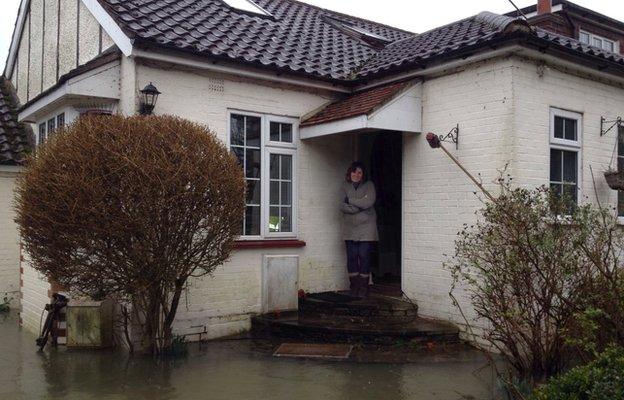
Mrs White moved in with her family in 2007. Unlike many of the families along the river, her children, Cameron, 12, and Thomas, eight, have not moved out, though they are at school when I visit.
The family are clearly very self-reliant, and she shows remarkably little concern at the flood waters lapping at her doorstep.
"We're perfectly fine," she says. "We've got another 7in to go. We've got a 4x4, we bought waders yesterday. We're getting by. This is the new normal."
They have a generator in their garage, which they can turn on remotely if their power goes, though they have not tested it yet.
They have not raised furniture and are not even considering moving out.
One of the main reasons is their animals - including rabbits, a new puppy, cats, chickens, goats and a lizard.
Roger White has raised the chickens' ark above the 2ft-deep water in the back yard. They huddle under the shelter from the lashing rain.
Mrs White's biggest concern is keeping the boys occupied. "They're going stir crazy - Monopoly and TV only last so long."
But the floods have brought new adventures. "They've been kayaking in the new lake out the back."
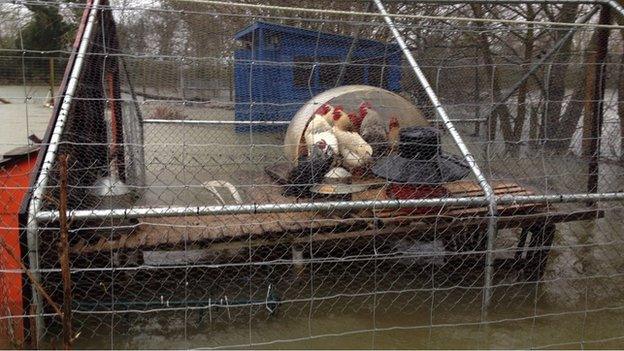
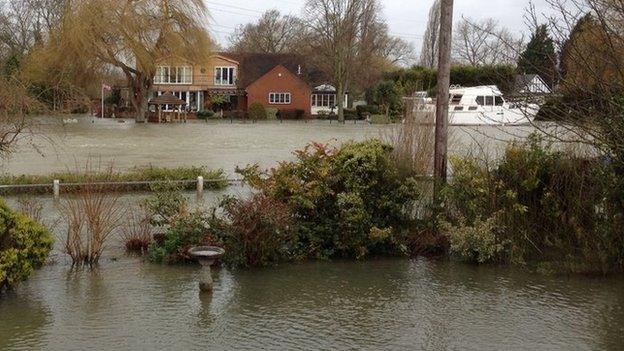
Towpath residents could now take a boat straight from their front door, across the Thames, and to the front door of houses on the islands opposite